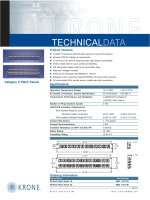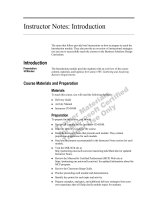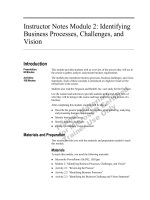Tài liệu Instructor Notes Module 6: Deriving a Physical Data Design doc
Bạn đang xem bản rút gọn của tài liệu. Xem và tải ngay bản đầy đủ của tài liệu tại đây (86.39 KB, 4 trang )
Instructor Notes Module 6: Deriving a
Physical Data Design
Introduction
This module describes how data is stored, the relational model, and how to
optimize database systems.
After completing this module, students will be able to:
!
Derive a physical data design for tables and fields from a logical data
design.
!
Analyze data usage characteristics to optimize a physical data design.
!
Determine methods for implementing relationships in a physical data
design.
!
Identify different optimization techniques.
!
Determine the proper criteria for optimizing a physical data design.
Materials and Preparation
This section provides you with the materials and preparation needed to teach
this module.
Materials
To teach this module, you will need the following materials:
!
Microsoft
®
PowerPoint
®
file P06_1609a.ppt
!
Module 6, “Deriving a Physical Data Design”
!
Activity 6.1, “Translating the Logical Data Design”
!
Activity 6.2, “Optimizing a Physical Data Design”
Preparation
To prepare for this module, you should:
!
Read all materials for this module.
!
Complete the activities.
Presentation:
75 Minutes
Activities:
55 Minutes
2 Instructor Notes Module 6: Deriving a Physical Data Design
Activities
Activity 6.1: Translating the Logical Data Design
In this activity, students will evaluate the logical design for a portion of the
Ferguson and Bardell, Inc. case study. From this design, students will determine
the appropriate tables, fields, and data types.
Students should fill in the blank grids in the activity manual with the tables,
fields, and data types they identify. More grids are available than students will
probably need, and each grid has more rows than they will probably need. Tell
students that they should not feel obliged to fill in all the rows of all the grids.
After the activity, lead a class discussion so that students can compare results.
After completing this activity, students will be able to:
!
Evaluate a logical data design.
!
Determine the appropriate data types for columns in a table.
!
Produce a physical data design.
!
To prepare for the activity
!
Complete the activity.
Activity 6.2: Optimizing a Physical Data Design
In this exercise, students will evaluate a data design and determine areas in
which it could potentially be optimized.
After the activity, lead a short class discussion so that students can compare
results.
After completing this activity, students will be able to:
!
Identify where data designs can potentially be optimized.
!
Determine the appropriate optimization technique.
!
To prepare for the activity
• Complete the activity. Try to think of alternative answers that students
might present, and be ready to discuss the merits of both your initial
answers and the alternatives.
Module Strategy
Use the following strategy to present this module:
!
Physical Data Design
For most students, this section will be a basic review of various types of
physical databases. You might have to spend a few moments on the data
types slide to ensure that students understand the various data types;
otherwise, you should be able to cover this section fairly rapidly. Note that
the data types listed in the workbook are generic. Actual data types will vary
depending on the databases that are used.
Instructor Notes Module 6: Deriving a Physical Data Design 3
!
Implementing Relationships
Again, for many students, this will be a review of material that they already
know. Plan to spend some extra time on the many-to-many design problem
and how it is usually solved. An additional example (for instance, students
and classes in an enrollment system) can be helpful.
!
Data Optimization Techniques
Unlike the previous two sections, this section might be new territory for the
majority of students. The data access needs of various application types is
covered, as well as ways of optimizing designs to accommodate these needs.
Be sure that students understand the importance of thoroughly considering
how the application will be used, and the necessity of good design choices
throughout the design process to reach performance goals.
THIS PAGE INTENTIONALLY LEFT BLANK









